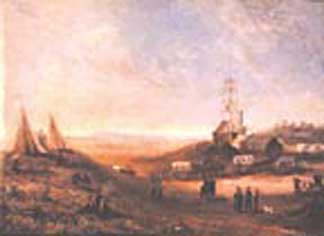
During the 19th century, many artists recorded Western exploration. Some were academically trained civilians and some were military-trained engineers and draftsmen. Their work was executed under difficult physical conditions, often permitting only the use of pencil, pen and sketch pad, or a small watercolor kit. Of the thousands of surviving visual records of Western exploration, precious few are oil paintings. A couple of these were painted during Captain John Pope's artesian well expedition on the Llano Estacado and Jornado Del Muerto of Texas and New Mexico from January of 1855 to June of 1858. In 1857, Secretary of War John B. Floyd designated Harry S. Sindall to be Pope's expedition artist. "Captain John Pope's Artesian Well Drilling Site" is a rare depiction of the activity of an expedition. Pope's Well, near the Pecos River crossing of the Texas-New Mexico line, became a landmark on the famous Goodnight-Loving Cattle Trail.
The Artist
Unrecognized for 140 years, Sindall was a Western Exploration artist of considerable merit. On May 22, 1857, Secretary of War Floyd designated Sindall to be Capt. Pope's expedition artist at a compensation of not less than $1,000 per annum. Also, according to a letter from Lt. Edward F. Beale to Floyd, February 9, 1860, Sindall had been - for a brief period - the artist for Beale's Wagon Road Survey. The volume of art produced by Sindall is not known at this time, but additional works are now being discovered.Official records indicate that Sindall enlisted in the Confederate Army at Richmond, Va., on June 27, 1861. He volunteered for the 1st Maryland Artillery, which was composed of men from lower Maryland, the Eastern Maryland Shore and Baltimore City. After four months, he was detached to the staff of Gen. Samuel G. French.
In the same area of Texas and New Mexico that Sindall roamed with Pope's expedition, French was a Captain of the Quartermaster Department. French had the duty of maintaining Wool's Road west out of San Antonio and diverging northward toward Las Moras Creek, the San Pedro and the Pecos. Pope's drilling equipment was acquired through the Quartermasters in San Antonio and Las Cruces, N.M. (see the "Trading Post" section in the May 1857 issue of National Driller).

Report Abusive Comment